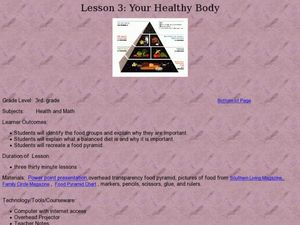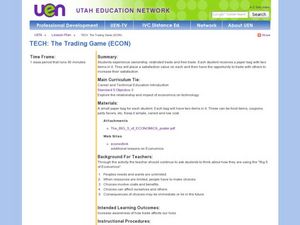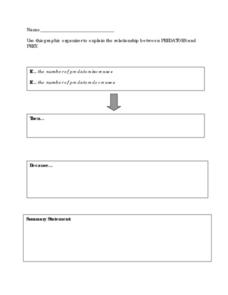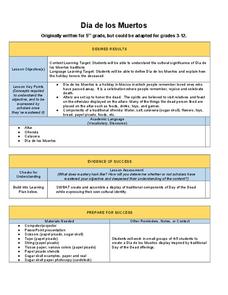Curated OER
Your Healthy Body
Third graders identify the food groups. In this nutrition lesson, 3rd graders examine the food pyramid and create a balanced diet plan. Students label a blank food pyramid outline.
Curated OER
Healthfully Ever After
Second graders discuss five food groups and healthy eating habits.
Consortium for Ocean Science Exploration and Engagement (COSEE)
Arctic Smorgasbord
Though the walrus spends roughly one third of its time on land, it eats organisms that live on the bottom of the ocean. The first in a series of five, the lesson uses a variety of plant and animal cards to have scholars build an arctic...
Polar Trec
Arctic Smorgasbord!
Two blooms of phytoplankton, instead of just one, now occur in the Arctic due to declining sea ice, which will have widespread effects on the marine life and climate. In small groups, participants build an Arctic food web with given...
Curated OER
TECH: The Trading Game
Property ownership, restricted trade, and free trade are the topics of this game. Kids play a trade game to better understand the interrelationship between technology, economics, and personal choices. Rules to the game and a series of...
Indian Land Tenure Foundation
Sharing Resources: The Nuts Game
The land has always provided its inhabitants with resources that allow them to survive. However, sometimes resources run scarce and sharing becomes an important task. Help little ones understand why and how people have shared resources...
Curated OER
The Riddle of the Playground Cave
Students discuss food groups and combination foods, and solve riddle story.
Science 4 Inquiry
Eukaryotic Cells: The Factories of Life
Eukaryotes include humans, animals, and plants. Scholars learn about the parts of eukaryotic cells. They design models of a store and match the correct function of each part to the function of a part of the cell. They review their...
Curated OER
Healthy Food Choices
Students, working in groups, role play skits highlighting healthy eating habits and physical activities.
Curated OER
Plankton in the Air
Here is a lab activity adequate for use with any full lesson on environmental factors that shape animal adaptations or marine animal characteristics. Pupils will discuss the role plankton plays in the environment and filter-feeding...
Houghton Mifflin Harcourt
Amazing Animals: Challenge Activities (Theme 4)
For kids who have already mastered the basic concepts in the Houghton Mifflin Harcourt thematic units on amazing animals, here's a packet of enrichment activities sure to provide food for fertile minds.
Curated OER
America, A Home for Every Culture
Students investigate the many cultures that are represented in America. In this American culture lesson, students look at the food, languages, music, and traditions that immigrants have contributed to the face of America. They complete...
Curated OER
Predators and Prey
Students explain how the food chain works. They contrast predators with prey and describe their function in nature. Students discuss how the food chain aids in keeping nature balanced. In small groups, they play a game that simulates the...
Curated OER
Predator/Prey
Learners explain how the food chain works. They contrast predators with prey and describe their function in nature. Students discuss how the food chain aids in keeping nature balanced. They play a game that simulates the food chain.
Science Matters
That’s An Otter Story
Young scientists discover how sea otters' habitats have changed due to human impact. Through conversation, video observation, and story reading, scholars identify how human interactions change a specific ecosystem in both positive and...
Curated OER
Babysitting and Child Care
The first job most of us ever experienced, was babysitting. Prepare young adults for the responsibilities of child care with Babysitting 101. They'll discuss safety, food preparation, and the that responsibilities babysitting entails....
Curated OER
Wanted: The Infamous Five
Pupils name the five most common types of foodborne pathogens. They comprehend how bacteria can grow and spread. Students are taught healthy hygiene and food-safety habits. They discuss the crimes of the five most wanted foodborne bacteria.
Curated OER
Hierarchy Theory and Biotic Hierarchy
Students examine the hierarchy theory and biotic organization by playing a teacher-created card game matching groups of items, such as organelles, in suits of four. They discuss the reasons for their hierarchical organization of the...
Curated OER
Similar and Different
Fourth graders observe a pair of students standing in front of the class and compare and contrast them using a Venn Diagram using these guidelines: eye color, hair color, older/younger, tallest/shortest, gender, favorite food, favorite...
Arizona-Sonora Desert Museum
Desert People and the Saguaro
The saguaro is the focus of an examination of the importance of this stately cactus to the indigenous people in the Sonoran Desert.
Curated OER
Importance of Fresh Vegetables and Fruits in Our Diets
Students explore the importance of fruits and vegetables in our diets. In this science lesson, students discuss various types of fruits and vegetables. Students play the good health=good diet game. Students discuss types of fruits and...
Curated OER
Needs & Wants
Second graders determine the definitions of needs and wants. They write the definitions down and make a personal list explaining their own wants and needs. They cut out pictures from magazines showing their wants and needs which they...
Curated OER
Exploring Limu Diversity
Students explore limu diversity. In this ocean ecosystem lesson plan, students classify limu according to its physical properties. Students work in small groups to generate scientific observations and sort limu by characteristics.
Vanderbilt University
Dia de Los Muertos
To honor El Dia de los Muertos, scholars work together to create Day of the Dead displays—paper sugar skulls and banners—that bring a festive and memorable flare to the classroom.























